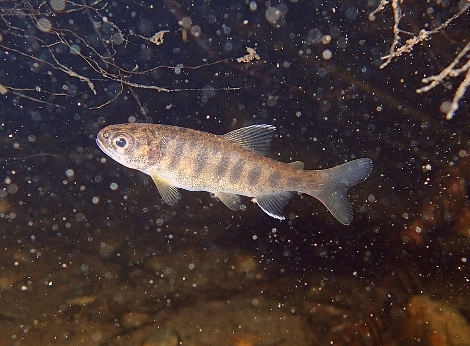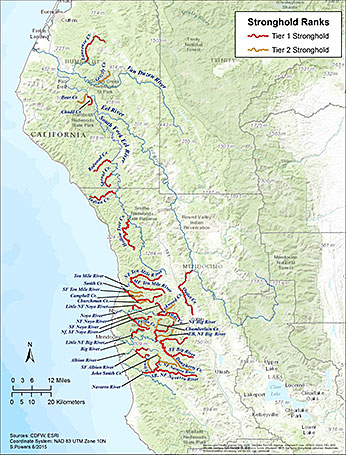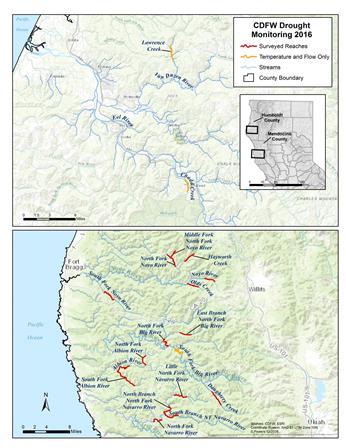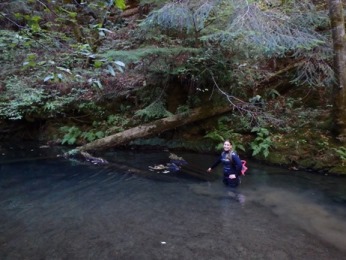(Humboldt and Mendocino counties)
2016 Update
Species / Location
 Figure 1. Juvenile Coho Salmon in Godwood Creek, Humboldt County. CDFW photo Teri Moore.
Figure 1. Juvenile Coho Salmon in Godwood Creek, Humboldt County. CDFW photo Teri Moore.
 Figure 2. Map of stronghold Coho Salmon streams monitored in southern Humboldt and Mendocino Counties. (click/tap to enlarge)
Figure 2. Map of stronghold Coho Salmon streams monitored in southern Humboldt and Mendocino Counties. (click/tap to enlarge)
 Figure 3. Maps depicting extent of study area, including surveyed streams (juvenile snorkel dives) and stream temperature logger deployment locations in Humboldt and Mendocino counties. (click/tap to enlarge)
Figure 3. Maps depicting extent of study area, including surveyed streams (juvenile snorkel dives) and stream temperature logger deployment locations in Humboldt and Mendocino counties. (click/tap to enlarge)
 Figure 4. CDFW divers observe and count coho salmon and steelhead trout.
CDFW photo S. Ricker, 6/15/15.
Figure 4. CDFW divers observe and count coho salmon and steelhead trout.
CDFW photo S. Ricker, 6/15/15.
 Figure 5. CDFW staff noting the location of a temperature logger in the NF Noyo River. CDFW photo J. Held.
Figure 5. CDFW staff noting the location of a temperature logger in the NF Noyo River. CDFW photo J. Held.
Drought has impacted populations of federally listed Southern Oregon-Northern California Coho Salmon and Coastal California Coho Salmon as well as steelhead in Humboldt and Mendocino counties (Figure 1).
Need for Drought Stressor Monitoring
Extreme drought conditions in California between 2012 and 2016 have led to concerns over the survival and health of salmon and steelhead populations. Threatened and endangered populations of Coho Salmon and steelhead are increasingly vulnerable during the summer time when they are rearing in streams as juveniles. Stream channel drying and elevated water temperatures can drastically reduce available habitat. Because salmon return to the same streams in which they were born, it is possible for these species to become locally extirpated if existing stronghold populations (relatively healthy populations that use high value habitat) are lost. Such local extirpation would lead to long term population decline for this portion of their range even after drought conditions subside and wetter trends return. While more transitory and dependent local populations may vanish temporarily due to drought conditions, they can become re-established if local, core stronghold population patches are maintained on the landscape.
Stressor Monitoring Efforts
To best insure these stronghold ‘seed stocks’ of our wildlife resources are kept intact through this difficult drought period, the California Department of Fish and Wildlife (CDFW) implemented a monitoring plan focused on Coho Salmon strongholds in southern Humboldt and Mendocino Counties (Figure 2). Streams were selected based on the best available knowledge of those containing significant Coho Salmon populations, risk for juvenile mortality, and analysis of 2015 Drought Stressor Monitoring data collection (Figure 3). CDFW staff collected real-time information on water quantity and quality coupled with a rapid assessment survey designed to evaluate salmonid population health.
- Water Quantity and Quality Measurements: achieved by stream discharge measurements at the bottom end of defined reaches, length of dry channel measured throughout each reach, and placement of water temperature loggers.
- Salmonid Species Distribution: consisted of performing snorkel dive surveys using a modified version of specific Coho Salmon spatial structure monitoring protocols developed by CDFW (Garwood and Ricker 2013).
This program allowed for informed management decisions, rapid response rescue operations, and other interventions applied strategically in response to local threat level and overall population risk.
Findings
CDFW designed the 2016 survey framework and stream reaches to be nearly identical to those completed in the 2015 Drought Stressor Monitoring survey, allowing for comparison to the 2015 baseline. CDFW surveyed 18 streams and over 33.4 miles of critical Coho Salmon stream habitat during the summer and early fall of 2016 (Figure 4).
In addition to juvenile salmonid snorkel dives, CDFW recorded monthly stream flow discharge and deployed temperature data loggers in 20 of these Coho stronghold streams in Humboldt and Mendocino counties (Figure 5). Most likely due to closer to average annual precipitation amounts, drought conditions lessened in some areas of Northern California (including Humboldt and Mendocino counties) from the 2014 water year to the 2015 water year. Stream conditions improved noticeably in some of the habitat requirements for juvenile salmon and steelhead rearing. The amount of dry channel was reduced from 15.5% in 2015 surveys to 7.9% in 2016 surveys (Table 1).
Stream temperatures remained suitable in all of the streams where water temperatures were recorded. The overall number of juvenile Coho Salmon and steelhead observed increased during the 2016 survey. These higher numbers were also reflected in an increase of juvenile Coho Salmon and steelhead observed per pool. Furthermore, while a fish rescue was completed in 2015 at Olds Creek, a tributary to the Noyo River, fish rescue operations were not required during the 2016 survey year due to sufficient stream flows and earlier rainfall in October of 2016.
Table 1. Comparison of 2015 and 2016 juvenile snorkel dive survey data collected during drought stressor monitoring survey efforts in Mendocino County watersheds.
| Watershed
|
Noyo River
|
Big River
|
Albion River
|
Navarro River
|
Totals
|
| Year
|
2015
|
2016
|
2015
|
2016
|
2015
|
2016
|
2015
|
2016
|
2015
|
2016
|
| Length of survey (m)
|
17,628
|
20,014
|
8,100
|
8,336
|
9,392
|
12,223
|
7,530
|
13,157
|
42,650
|
53,730
|
| % Dry Channel
|
20.2
|
3.2
|
8.3
|
0.1
|
13.0
|
13.0
|
15.3
|
15.3
|
15.5
|
7.9
|
| # of pools snorkeled
|
251
|
298
|
143
|
104
|
77
|
67
|
107
|
122
|
578
|
591
|
| Juvenile Coho
|
3,024
|
3,608
|
1,768
|
1,505
|
2,291
|
1,794
|
76
|
925
|
4,437
|
7,832
|
| Juvenile Coho/pool
|
12.6
|
12.1
|
12.7
|
14.5
|
29
|
26.8
|
2.8
|
1.6
|
7.7
|
13.3
|
| Juvenile Steelhead
|
1,158
|
2,456
|
1,259
|
616
|
388
|
143
|
46
|
998
|
2,851
|
4,213
|
| Juvenile Steelhead/pool
|
5.7
|
8.2
|
8.5
|
5.9
|
4
|
2.1
|
14.9
|
8.2
|
4.9
|
7.1
|
Future Efforts
While the beginning of the 2016 water year in northern California has been above average, it is too early to predict if sufficient precipitation will continue throughout the winter and spring months to potentially begin to alleviate the effects of the prolonged drought period (2012-2015) in Humboldt and Mendocino counties. Climate projections indicate the strong possibility of California continuing to experiencing a drier climate. This study has enabled the collection of valuable data regarding stream habitat conditions and distribution of sensitive and endangered salmon and steelhead populations during this extended drought period. Information regarding where, when, and under what conditions animals are distributed is necessary baseline information for directed resource management in the context of changing conditions. CDFW is committed to protecting and managing our natural resources. Efforts like this project and others across California play a vital role in ensuring our valuable fisheries’ resources remain intact for future generations to enjoy.
References
- Garwood, J. and Ricker, S. 2013. 2013 Juvenile Coho Salmon Spatial Structure Monitoring Protocol: Summer Survey Methods. California Department of Fish and Game, Arcata, CA.